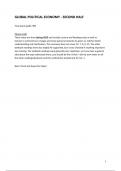GLOBAL POLITICAL ECONOMY - SECOND HALF
Final exam grade: 9.9
Please read!
These notes are from Spring 2023 and include Lecture and Reading notes as well as
lecturer’s comments (in orange) and some personal remarks (in green or red) for better
understanding and clarification. This summary does not cover Ch. 7, 8, 9, 15. The other
textbook readings were also largely AI-supported, but I cross-checked if anything important
was missing. The textbook readings were generally very repetitive, so if you have a general
idea about the topic addressed there, you should be fine I think. I did my own notes on all
the other readings/podcasts and this method has worked out for me. :)
Best of luck and hope this helps!
1
,Lecture 7: What’s Next? Hegemonic Cycles and Historical
Capitalism since 1431
Notes
Introduction
● GPE can be told as a “story”
● stories have a political character
● When people represent social life, they use a variety of different tools, incl. texts,
statistics, visualization
§100 Trillion World Economy: Estimation of Global GDP
● GDP is an estimation and it doesn’t tell a lot of stuff that is needed
● Estimation of formal economic output which is why it remains the favorite proxy
when talking about size of economic pie
● Informal economy not represented, certain narratives left out
● China and US = largest economies
● Europe represents a comparatively large part in the Global Economy
● Latin America, Middle East, Africa = underrepresented
● World population living in extreme poverty has declined rapidly (one story)
○ based on a dollar/day line → measure problematic
● Global wealth distribution (the other story)
○ largest 1st% of world population holds 45.8% of global wealth
○ 55% percent of world population hold 1% of global wealth
Agenda:
1. GPE as a (different) way of seeing world economy
2. Theoretical traditions reflect assumption, normative stances
a. How these different theoretical traditions analyze the world economy
b. Looking at the normative implications
3. The historical development of the world market
2
,Part 1: GPE as a (different) way of seeing the world
Introductory Overview of the Course
GPE involves various disciplines and economic perspectives → multiple lenses
What is GPE?
● addresses world economy, its development, dynamics and effects
○ politics and economy must be understood together
○ Ricardo’s Comparative Advantage is an abstraction, was never based on “field
work” → it is context free
○ This course wants to bring in context
● draws on multiple, sometimes rival theoretical traditions
○ rejects key assumptions of economic, draws on certain insights
○ Ex: Model of humans as only being self-optimizing is rejected because
actually, human behavior is shaped by other important considerations, e.g.
process, outcomes and preferences change over time
● A multidisciplinary and in respects post-disciplinary field of study
○ old, recent, changing
○ Ex: Decentering Europe and also looking at differences within countries
Focuses of contemporary GPE
● Economic growth or Capital Accumulation
○ A key concern, not privileged → being agnostic towards economic growth
○ important features of any economic, difference between use value and
exchange value
○ How much can/should an economy produce?
○ Degrowth because of economic footprint
● Welfare, fulfillment of needs, capabilities development, ‘real freedom’ (ability to
actually do things)
○ Inequalities as a key feature of social life
○ “There’s nothing intrinsically good or bad about equality, we want to evaluate
equality as the perception of it is subjective” → one has to have evidence to
sustain claims
● Environment, the ecosystem as the basis of economies
○ Colossal failure of conventional economic approaches
Global Political Economy
● affirms social, political foundations of the world economy
○ historically grounded, attention to path dependence, agency
● recognizes states’ unique roles but that state capabilities are contingent
3
, ○ emphasized increasingly transnational features of world market (free
movement of people and goods)
● views world from different standpoints, perspectives
○ does not embrace any one view of how world is, ought to be
Attention to backstage aspects of the world market
● Attention not just on present but historical path to present
○ historical expansion of world economy
● Attention not just on world market but political basis
○ Formation of world market in relation to inter-state system, unequal rights
○ “Different people in different parts of the world were granted certain rights,
some got more rights than others”
● Attention not just on trade but sites of production
○ Understanding that production for the world market involves living, breathing
people
● Attention not just on production but also reproduction
○ Appreciating the reliance of the world economies and economies within it on
unpaid, informal work, social policy
○ e.g. care work; informal economies
● Attention not just on the economy but on nature
○ Rethinking the world economy in a way that foregrounds sustainability, as
opposed to old/traditional ways
Part 2: Theoretical Traditions in GPE
reflect normative stances
Main Traditions
Each of these traditions has a lot of diversity within them
1. Liberal, neoclassical (economics) political economy
2. Critical political economy
3. State centered / Nationalist / “Developmentalist”
Analytical focuses and perspectives
1. Broadening performance analytics
a. not only/mainly growth –< welfare, inequality, environment
2. Globalizing global political economy
a. diversity, world history, area studies, interdependence
3. Multi-dimensional awareness
4





